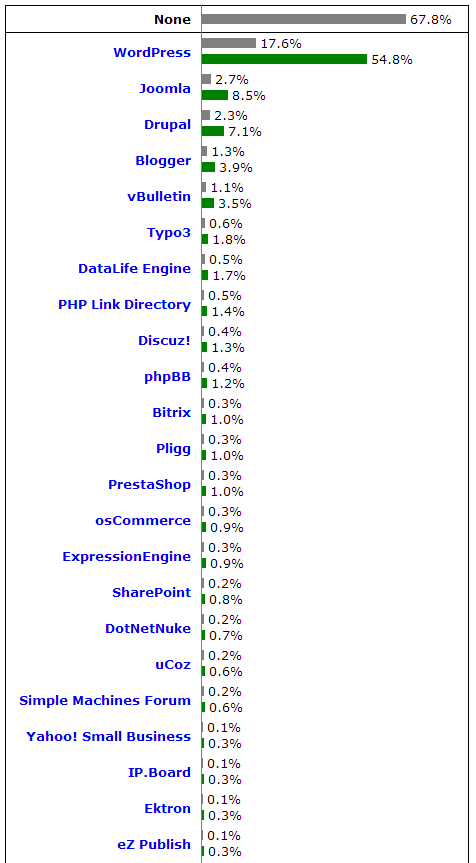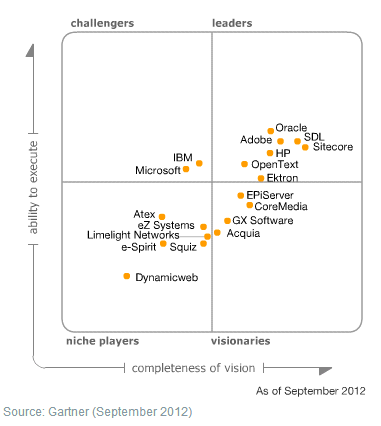Recently I was participating in an online course (on Coursera) and one of the task was to do an industry analysis. So I did it for web design and development industry focusing on 2 parts:
- tools (content management vendors)
- creative touch (web agencies)
Be aware that I don't do these kind of analysis professionally :)
Be aware that I don't do these kind of analysis professionally :)
Lets first define the scope:
“Web development is a broad term for the work involved in developing a web site for the Internet (World Wide Web) or an intranet (a private network). Web development can range from developing the simplest static single page of plain text to the most complex web-based internet applications, electronic businesses, and social network services. A more comprehensive list of tasks to which web development commonly refers, may include web design, web content development, client liaison, client-side/server-side scripting, web server and network security configuration, and e-commerce development.” - Wikipedia
According to Netcraft there are close to 200 000 000 active web sites in the world as of April 2013. Note that this is only counting publicly available sites. Number of extranets and intranets is not possible to know, but it is certainly in millions.
Source: Netcraft Web server survey
The industry is still growing just by numbers. Enterprises, organization and people all around the world want to be presented on Internet. Younger population will drive this growth in the future. Mobile and tablet usage is expanding the time when people use Internet. So we are spending more and more on Internet while we are not sitting in front of the desktop computer.
Source: comScore
So in the future the demand for development will increase even more for several reasons:
- Internet access is still increasing all around the world
- more and more devices will use web technology to access information.
- adoption of web technology on the public web is increasing the usage of same tools on non-public areas like business applications, intranets, etc.
- user demands and trends in web development are dictating redesign of web sites every few years (currently the trend is to adopt the web sites to mobile and touch devices, only a small fraction of sites did it so far)
- also the global trend is to put more and more business process on line, which is driving more complex web solutions to be built
There are many levels in the industry structure, naming the most important:
- infrastructure (like hosting, virtual machines, collocated servers, etc)
- system platforms (operating systems, web servers, databases, ...)
- standards and tools (HTML/CSS, managing web content, users, processes and workflows )
- "creative touch" (applied branding, development of custom features, user experience, ... )
In this post we will focus on last 2 segments.
Standards and tools
In the first years of web there were just standards (like HTML) but as the number and complexity of web sites grew lot of tools emerged. In recent years web content management systems are dominant tools for building web sites. We will focus on those systems in this postand leave the standards aside as not important for the scope.
“A web content management system (WCMS) is a software system that provides website authoring, collaboration, and administration tools designed to allow users with little knowledge of web programming languages or markup languages to create and manage website content with relative ease.” - Wikipedia
Statistics show that roughly 32% of those sites use some form of known WCMS.
Source: w3tech.com
Other either use none or use some unknown system (probably custom made). There are hundreds of known WCM systems. How big is the industry can be viewed on Wikipedia: List_of_content_management_systems
As there are so many competitors there are also many levels where they compete:
- development model (open source vs closed source)
- business model (free of charge vs enterprise vs hybrid)
- deployment model (cloud vs self-hosted )
- underlying technology (PHP vs Java vs Python vs ...)
In terms of pure numbers Wordpress, Joomla and Drupal are the clear top 3. What is interesting is that all 3 have open-source development model, they are free to use, based on LAMP technology (Linux, Apache, MySQL, PHP) and can be self hosted (with optional cloud service). Even more interesting is that all 3 are not making much money for the product owners. Wordpress and Drupal have small company behind that is charging consultancy and hosting (cloud), Joomla is purely community driven.
Lets put these 3 in one group with all similar systems and call it the Open market segment. Usually, as there are license fees, other things decide on which product to use. Things like developers preference, ease of use and innovation.
Is the Open market segment attractive industry to be in?
- economies of scale are possible as proved by Wordpress and others. But the problem is commoditization. There is a lot of tools that are free to use. Learning curve is not too big. There is a lot of code written in existing solutions tested on many projects. Brand loyalty is strong as the industry is community driven. Developers learn usually one platform and tend to use certain solutions rather than others
- capital requirements are low, but building a community of developers is not easy and takes time
- substitutes exists in form of social platforms that are making possible to create a simple web presence without a WCMS (like Facebook, Google+, Pinterest), complementary products exists in form of simple ERP, eCommerce, CRM, etc
- suppliers are not powerful, the platforms are commoditized too
- as there is no price buyers have the option to switch any time but tend to stick to their community
As opposed to Open market segment there are solutions which are not free and not oriented to mass market. Lets call it the Enterprise market segment. The best overview of this segment is provided by Gartner’s Magic Quadrant
The segment consists of products generating more than 10M USD yearly. Most of those products are:
- charging licenses or subscriptions
- developed as closed source
- capturing bigger and more complex projects
- offering stability, support and integration possibilities
It is not easy to enter this segment as you need to prove on bigger projects. The group is slowly threatened by some of the products from first group with disruptive community size and business models. Good examples are Acquia (company behind Drupal with its big community) and eZ Systems (company behind eZ Publish with its dual licensing model).
Is the Enterprise market segment attractive?
- economies of scale are possible and the market is always threatened by the lower segment players with larger number of users. Learning curve is big: there is a lot of complex features implemented and tested on many projects. Brand loyalty is strong as this industry is community driven. Developers learn usually one platform and tend to use certain solutions
- capital requirements are medium, but building a community of developers is not easy and takes time
- substitutes are players from lower segment, complementary products exists in form of enterprise ERP, ecommerce, CRM,...
- suppliers are not powerful, most platforms are commoditized
- ECM tools usually integrate more deeply into the clients ecosystem so switching costs are higher: buyers don’t have an edge
To conclude this part about WCMS products it is important to note that, as already mentioned, vendors are community driven. Each successful vendor tends to have a large number of developers and integrators that use the system for their projects. They are either freelancers, in-house developers or external agencies. Some vendors have developed a partner network to support the growth.
“Every software vendor or project has a community regardless of their business model or their license or whether or not they choose to invest in that community. And most software vendors have partners. These are firms who install, configure, customize, and extend the vendor’s software. The partnership formalizes the business relationship between the partner and the vendor.” - Jeff Potts
In the next part we will focus on web design & development companies which are using WCM systems to build web sites for their clients.
Creative touch
It is very hard to asses the competition for this level. For example there are almost 5000 companies listed as web development companies in UK. We can assume that there could be hundred of thousands of such companies around the world. Of course, not all are competing with each other as most of them have local or regional focus, but it is possible to compete on global scale too.
There are several of different profiles:
- marketing agencies working with clients on their web projects as a part of broader marketing actions
- web design agencies focusing on web projects only
- web development companies working for first two
- general development companies working on web projects too as a part of broader software projects
- freelancers
All of them have different capabilities and aiming for different clients. E.g. Marketing agencies tend to outsource development, general development companies tend to outsource design, etc.
Most importantly the type of business is:
- service oriented (tools like frameworks, CMS-es and similar are used but major work is unique and customized for the client)
- locally oriented (to be closer to the client)
- client oriented (sometimes the web site development is just a part of the bigger Marketing projects for the client)
So competition is fierce and it is easy to enter the market. Competition is based on making successful projects and building reference list, thus charging more per hour. The knowledge and experience growth inside the company is crucial to stay on top of the game. Although the industry as a whole is still in growth phase there are many smaller innovation cycles generated by user needs and/or technology improvements.
At this moment multichannel features are “hot”, for example Responsive Web Design is just starting to be implemented on sites that want to provide better user experience on more channels (mobile, tablet, desktop, ...). The web sphere is basically reinventing itself every few years.
Is this an attractive industry?
- economies of scale are achieved on a very basic level, there are companies like Tumblr which are providing very very simple blog sites and can scale. But the main problem is that lot of clients need and want unique design and custom features (but are not able to make them on their own)
- capital requirements are really low, learning curve exists but you don’t need to know much to make a simple web site. The bigger and more complex project is, the more learning and experience is needed.
- clients tend to stick to one service provider if it doesn’t suck too much, but innovation cycles every few years and possible branding changes give clients opportunity to change the provider
- due to large number of service providers there are many substitutes but also many complimentary services that can be sold to the same client: hosting, cloud, platform, maintenance, integration etc.
- suppliers are not powerful except for biggest projects, the tools are commoditized and lot of free of charge. Usually the biggest cost in a project is custom design and development time
- buyers have the option to switch but the switch requires time and effort. Web projects usually go under marketing budgets which are not stable. There is a usually a standard price per hour on each local market established, with newcomers charging less and doing smaller projects and established providers charging more on bigger projects.
The most important remark is that it is very hard to scale business in this industry. For a company to scale it needs to give prepared solutions meeting client needs with a very easy way to change branding and visual appearance. This is yet to be achieved on a global scale but should be possible in vertical niches.
______
Hope that someone will find this post interesting :)
Photo credit: Designed by Freepik




